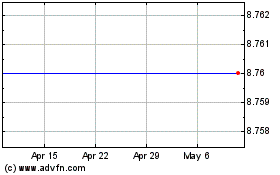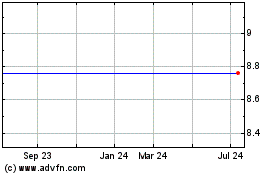The ink is barely dry on legislation to lift a 40-year-old ban
on exporting U.S. crude and energy companies already are jockeying
to ship American oil overseas.
Two tankers filled with freely traded U.S. oil have pulled out
of Texas ports in the past two weeks, with more shipments expected.
The first American oil sales abroad are flowing to Europe but, in
the longer term, Latin America and Asia could become natural
markets, according to industry experts.
U.S. oil sales to foreign buyers have been quick to start after
President Barack Obama signed the bill that abolished the crude
export ban less than a month ago. Big energy infrastructure
companies including Plains All American Pipeline LP and Enterprise
Product Partners LP have spent the past five years pouring billions
of dollars into building new pipelines, oil storage tanks and dock
space at ports.
The first freely traded cargo of U.S. oil was shipped from
Corpus Christi, Texas, on New Year's Eve. ConocoPhillips pumped the
oil from around Karnes County, Texas, 60 miles south of San
Antonio. From there it will travel about 5,000 miles to Bavaria in
Germany.
A second cargo of U.S. oil shipped from Enterprise's Houston
terminal at the start of the year is sailing to Marseilles, France.
From there it will move by pipeline to a refinery in
Switzerland.
During the drilling boom, infrastructure companies reworked the
country's pipeline network so American crude could move from inland
shale fields in West Texas and North Dakota to the coasts where
most refineries are located. One such hub is Corpus Christi, where
pipeline company NuStar Energy Inc. has been quietly building out
its oil network with an eye toward exports.
The company loaded the first tanker of freely traded U.S. oil on
New Year's Eve and has said it can load up to 400,000 barrels a day
from its existing terminal in Corpus Christi, said Danny Oliver,
senior vice president of marketing and business development.
NuStar isn't done expanding; it is in the process of boosting
its oil-loading capacity in Texas by more than 40% to 575,000
barrels a day.
"We could export 100% of the crude oil that comes through our
system," Mr. Oliver said.
In the short term, NuStar is unlikely to export that much on its
own because global demand for crude hasn't kept up with the
staggering amount of supply being pumped world-wide. As oil
supplies have swelled over the past 20 months, oil prices have
dropped by $75 a barrel to almost $30.
Corpus Christi is home to other energy companies that want to
export. At its peak in August 2014, the port shipped out more than
750,000 barrels a day, mostly to U.S. or Canadian refineries,
according to Housely Carr, an analyst with RBN Energy LLC in
Houston.
"That could make Corpus a major center of crude exports going
forward," he said in a recent research note.
The oil being shipped abroad is light, sweet crude, which is
pricier than the heavy crude U.S. refiners are equipped to process,
noted Skip York, vice president of integrated energy at Wood
Mackenzie. "The barrels leaving U.S. are a better fit for other
refiners" around the world, he said.
Ryan Lance, chief executive of ConocoPhillips, expects the
global oil glut to diminish in the next year or two as low crude
prices spur demand for fuel.
As demand rises enough to push crude prices higher, Mr. Lance
predicts that foreign buyers may come to rely on the U.S. to export
as much as two million barrels of oil every day within the next
five years.
Reaching that level of exports—which amounts to more than 20% of
current U.S. oil production—would require many more new pipelines
and oil terminals. "We've got some work to do," he said.
Canada's Enbridge Inc. has said it would spend $5 billion to
build three oil terminals between Houston and New Orleans to allow
U.S. and Canadian crude to flow overseas from the Gulf Coast.
Enterprise Products Partners acquired several docks on the Houston
Ship Channel when it bought Oiltanking Partners in a $6 billion
deal last year and is expanding loading capacity there.
As with most new markets, the flow of American oil abroad is
expected to start with a trickle and then steadily rise. The
current price of foreign crude isn't much higher than what a barrel
of U.S. oil can fetch, making a tanker ride across an ocean look
expensive to many buyers, experts said.
Oil pumped in producing countries from Norway to Nigeria is
similar to the crude flowing out of Texas, but those countries are
closer to Europe and Asia, making their shipments more attractive
to buyers there for now, according to an analysis by RBN. But a
massive expansion of the Panama Canal, scheduled to be complete
later this decade, will allow much larger ships to pass through.
That has the potential to open up new trade routes between the Gulf
of Mexico and Asia.
Prospects looks brighter if the price of crude rises to $40 or
$50 a barrel, said Ken Medlock, senior director at Rice
University's Center for Energy Studies.
"Longer term, the opportunity for crude exports will depend
entirely on price," he said.
Erin Ailworth and Christian Berthelsen contributed to this
article.
(END) Dow Jones Newswires
January 12, 2016 19:35 ET (00:35 GMT)
Copyright (c) 2016 Dow Jones & Company, Inc.
Plains All American Pipe... (NYSE:PAA)
Historical Stock Chart
From Mar 2024 to Apr 2024

Plains All American Pipe... (NYSE:PAA)
Historical Stock Chart
From Apr 2023 to Apr 2024
